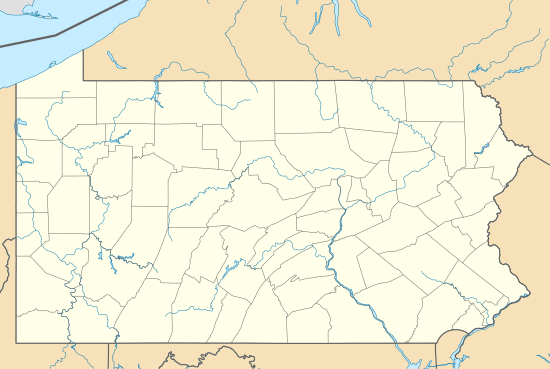Wade Dump
| Wade Dump | |
|---|---|
| Superfund site | |
| Geography | |
| City | Chester |
| County | Delaware County |
| State | Pennsylvania |
| Coordinates | 39°50′04″N 75°22′39″W / 39.834336°N 75.377632°WCoordinates: 39°50′04″N 75°22′39″W / 39.834336°N 75.377632°W |
 Wade Dump | |
| Information | |
| CERCLIS ID | PAD980539407 |
| Contaminants | Arsenic, chromium, mercury, lead, PCBs, plastic resins, VOCs |
| Progress | |
| Proposed | 12/30/1982 |
| Listed | 09/08/1983 |
| Construction completed | 06/29/1988 |
| Deleted | 03/23/1989 |
| List of Superfund sites | |
Wade Dump is a once-polluted Superfund cleanup site in Chester, Pennsylvania. Located on the western bank of the Delaware River under the Commodore Barry Bridge, the three-acre site once served as a rubber recycling facility and an illegal industrial waste storage and disposal facility.
The site was cleaned up in several stages, then removed from the National Priorities List in 1989. In 2004, it was turned into a parking lot for the city's Barry Bridge Park with EPA and state approval.
Contamination
From about 1950 to the early 1970s, the site hosted Eastern Rubber Reclaiming, a rubber recycling facility. The site later became an illegal industrial waste storage and disposal facility, and operated until 1978. Workers stored drums on site, or dumped their contents onto the ground or into various trenches, severely contaminating soil and ground water. Some of the wastes included polychlorinated biphenyls (PCBs), acids, cyanide salts, and other toxic chemicals.
In 1978, an intense fire at the site destroyed one building and damaged two others where drums of waste were stored. Local hospitals treated 47 firefighters for injuries sustained during the fire. A 2000 investigative series in The Philadelphia Inquirer detailed the many health problems endured by first responders in the years since the fire including several deaths from rare cancers. Emergency personnel were unaware of the toxic nature of the waste stored on the site and many firefighters stood in toxic sludge and breathed in fumes emanating from the fire.
At the time, an estimated 3,000,000 gallons of waste chemicals were stored in and around the buildings. About 150,000 gallons of waste materials remained on site after the fire, along with burned building debris, exploded drums, tires, shredded rubber, and contaminated earth.
The dumping and the fire contaminated groundwater and soil with PCBs; plastic resins; volatile organic compounds (VOCs); and heavy metals, including arsenic, chromium, mercury, and lead. The toxins threatened area residents and workers, surrounding wetlands, wildlife, and marine animals.
Cleanup
In late 1981 and early 1982, the EPA conducted two emergency cleanups in which workers removed an estimated 5,000 gallons of PCB-contaminated waste, 10,000 gallons of other hazardous wastes for incineration and 155 tons of contaminated solids.
In 1984, a long-term cleanup plan was developed for the site cleanup which was to be managed by PA DER. The work took place in 1987. Tires, tankers, debris piles, and buildings were removed, decontaminated, and disposed of. Contaminated soil was removed to depths with acceptable levels of contamination or to the level of the water table. The site was leveled, filled, and graded, then covered with topsoil and seeded to minimize erosion. EPA, in conjunction with the state, deleted the site from the National Priorities List in 1989.
In 2004, with EPA and state approval, the site was given drainpipes to clear stormwater and paved with asphalt to create a parking lot for the city's Barry Bridge Park.
In 1993 and 1999, five-year reviews concluded that the site is not a danger to human health or the environment. A third five-year review in 2004 concluded that the paving and drainage better protected human health and the environment.
See also
References
- "Wade (ABM) Current Site Information". Environmental Protection Agency. June 2008.
- "Superfund Site Progress Profile WADE (ABM)". Environmental Protection Agency. Jan 2009.
- "Beyond the Flames". Philadelphia Newspapers Inc. April 2000.